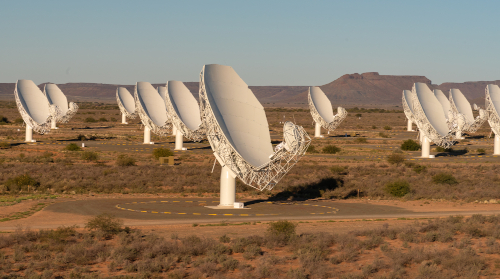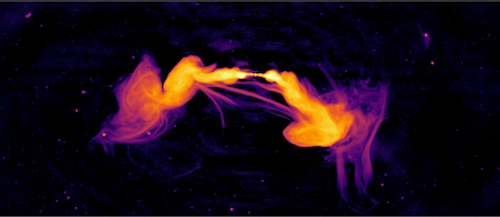Next Generation Radio Astronomy
Radio astronomy uses radio antennas, rather than mirrors and cameras, to detect radio emission from astronomical objects. Many things in the Universe emit radio waves, including stars, planets, supernova remnants, pulsars, fast radio bursts, and active galactic nuclei. The neutral hydrogen atom also emits very weak radio waves. A number of Bristol Astrophysics theme members use radio telescopes for their research.
The larger the telescope, the fainter and more distant objects it can detect. The resolution, or the ability to see fine details, also improves with increasing telescope size. Therefore, we want to build the largest telescopes possible.
The largest single-dish radio telescope in the world is an impressive 500 metres across. However, instead of building increasingly large dishes, which becomes more difficult and expensive, radio interferometry replaces the single dish with many smaller dishes, and connects them together so they act as a single telescope. This provides a way to keep the sensitivity and resolution of a large telescope, while building more cost-effective smaller dishes. See Fig 1 for a view of some of the dishes of the 64-dish MeerKAT radio interferometer, located in South Africa. Each dish is only 13.5 metres in diameter, but when combined, they have the sensitivity of a dish 108 metres across, and the resolution of a telescope 8 kilometres across!
Neutral Hydrogen
The most abundant element in the Universe, hydrogen is the raw material from which stars form. Neutral hydrogen only emits at radio wavelengths, so the only way to observe this fundamental material in emission is with radio telescopes. The emission from hydrogen is very weak, much fainter than the optical emission from stars, so large radio telescopes are needed to detect the signal. Observing the hydrogen reservoirs of galaxies not only tells us about their past star formation history, but also their future star formation potential. It is also very sensitive to disturbances, so gives clues about a galaxy's surroundings, and interactions with other galaxies.
Active galactic nuclei
Under certain circumstances, the process of accreting material onto a black hole can produce large amounts of radio emission. These are a class of active galaxy called radio galaxies, that can have radio jets and lobes extending over thousands of light years. Radio telescopes give a unique view of these powerful objects. See Fig 2 for an example of a radio galaxy observed with MeerKAT.
Towards the SKAO
The global astronomy community is collaborating on building the next large radio telescope interferometer, called the Square Kilometre Array Observatory (SKAO). With one telescope located across southern Africa, and another in Western Australia, these facilities represent the next generation of radio telescopes, enabling observations and discoveries not possible with existing instruments. The operational headquarters are located in Jodrell Bank, near Manchester, so the UK is a core partner in the SKAO project. By using existing telescopes for our research, such as MeerKAT, we will build expertise in advance of the start of SKAO operations in the coming decade, and be ready for the science the SKAO will enable.
Working in this area

